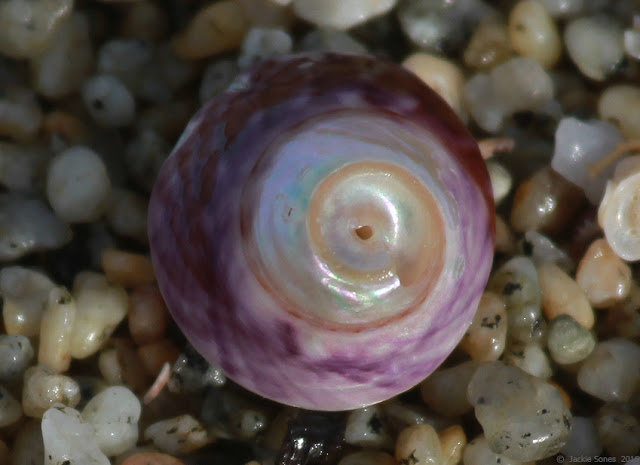Eric and I have been continuing our surveys for unusual marine invertebrates appearing during this year's El Niño conditions. Last Saturday, it was very stormy and rainy, and we were wondering whether we should go out — but we put on our boots and rain gear and headed for Salmon Creek Beach.
When the waves are really big, sometimes they "clean" the beach, i.e., there's not much to find. Here's what the beach looked like on 5 March 2016:
We had walked for a while without seeing much, and then Eric noticed a large black plastic cap that had recently washed up. He looked inside, and wondered about some small anemones on the inside edge of the cap. We couldn't immediately recall seeing anemones on floating debris, so Eric was curious about their identity. Below is a picture of the cap and the anemones as we found them:
We couldn't identify the anemones in the field, so we brought them back to the lab for a closer look. The anemones opened up, expanding their tentacles. There were over 20 anemones in the cap!
This was our first view under the microscope:
And a close-up of the tentacles:
The white markings and cross-bands on the tentacles reminded us of Anthopleura artemisia, but overall the anemones didn't look quite right for that species.
We knew something was unusual when we saw the sides of the column. We weren't familiar with a local anemone with red "punctations" or spots like this:
Along with the red spots, note the short white stripes at the base of the column:
Without a guide to anemones elsewhere in the world, we started looking around online, and we also sent a few pictures to Jim Carlton.
Here's the exciting part: Jim suggested the possibility of Anthopleura buddemeieri, a species from the Indo-Pacific (e.g., Papua New Guinea)! Separately, we found pictures of an anemone identified online as Anthopleura asiatica, a species from Japan. (Could this be debris from the tsunami of 11 March 2011?) Both of these species have distinctive red spots on the column.
Unfortunately, it sounds like the taxonomy of A. asiatica is confusing, so identifying these anemones might be challenging. But we're working on it! And either way, this is a very unusual species to find in Northern California. We are not aware of any records of these western Pacific anemones finding their way to North America. Imagine the possible routes across the Pacific Ocean. For example, can you visualize a small black cap crossing from the tropical Western Pacific to Baja and then drifting north along the West Coast of the United States until it washed up in Bodega Bay (over 10,000 km/6,000 miles)?!
Here's another thing to wonder about:
At least one of the anemones was undergoing fission — splitting into two genetically identical individuals. Is it possible that all of the anemones in this cap are related, i.e., that they started out as one individual and that they continually divided during their long journey across the Pacific?
I'll provide an update if we learn anything more. And for now, enjoy another close-up:
P.S. Proof that it's always worth going for a walk, even in the rain!
ADDENDUM (12 March 2016): Eric did a careful count of the anemones. It turns out that there were 39 (!) anemones on the cap. The average size was ~7-8 mm across.


















































